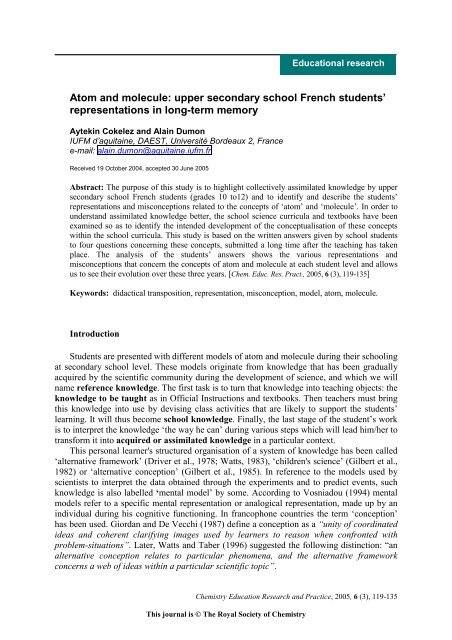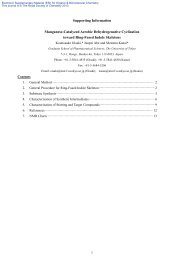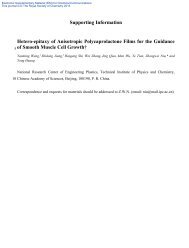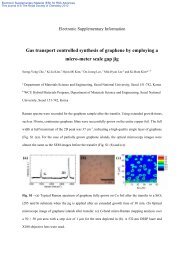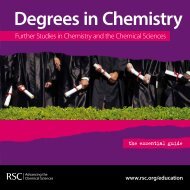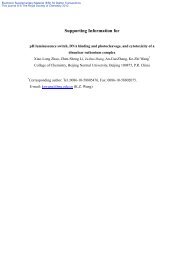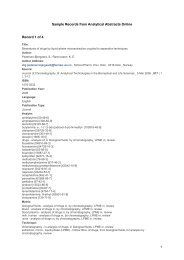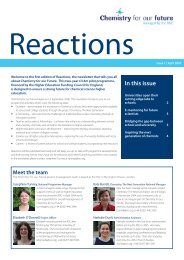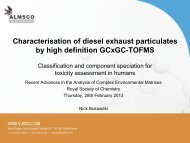Atom and molecule: upper secondary school French students ...
Atom and molecule: upper secondary school French students ...
Atom and molecule: upper secondary school French students ...
You also want an ePaper? Increase the reach of your titles
YUMPU automatically turns print PDFs into web optimized ePapers that Google loves.
Educational research<br />
<strong>Atom</strong> <strong>and</strong> <strong>molecule</strong>: <strong>upper</strong> <strong>secondary</strong> <strong>school</strong> <strong>French</strong> <strong>students</strong>’<br />
representations in long-term memory<br />
Aytekin Cokelez <strong>and</strong> Alain Dumon<br />
IUFM d’aquitaine, DAEST, Université Bordeaux 2, France<br />
e-mail: alain.dumon@aquitaine.iufm.fr<br />
Received 19 October 2004, accepted 30 June 2005<br />
Abstract: The purpose of this study is to highlight collectively assimilated knowledge by <strong>upper</strong><br />
<strong>secondary</strong> <strong>school</strong> <strong>French</strong> <strong>students</strong> (grades 10 to12) <strong>and</strong> to identify <strong>and</strong> describe the <strong>students</strong>’<br />
representations <strong>and</strong> misconceptions related to the concepts of ‘atom’ <strong>and</strong> ‘<strong>molecule</strong>’. In order to<br />
underst<strong>and</strong> assimilated knowledge better, the <strong>school</strong> science curricula <strong>and</strong> textbooks have been<br />
examined so as to identify the intended development of the conceptualisation of these concepts<br />
within the <strong>school</strong> curricula. This study is based on the written answers given by <strong>school</strong> <strong>students</strong><br />
to four questions concerning these concepts, submitted a long time after the teaching has taken<br />
place. The analysis of the <strong>students</strong>’ answers shows the various representations <strong>and</strong><br />
misconceptions that concern the concepts of atom <strong>and</strong> <strong>molecule</strong> at each student level <strong>and</strong> allows<br />
us to see their evolution over these three years. [Chem. Educ. Res. Pract., 2005, 6 (3), 119-135]<br />
Keywords: didactical transposition, representation, misconception, model, atom, <strong>molecule</strong>.<br />
Introduction<br />
Students are presented with different models of atom <strong>and</strong> <strong>molecule</strong> during their <strong>school</strong>ing<br />
at <strong>secondary</strong> <strong>school</strong> level. These models originate from knowledge that has been gradually<br />
acquired by the scientific community during the development of science, <strong>and</strong> which we will<br />
name reference knowledge. The first task is to turn that knowledge into teaching objects: the<br />
knowledge to be taught as in Official Instructions <strong>and</strong> textbooks. Then teachers must bring<br />
this knowledge into use by devising class activities that are likely to support the <strong>students</strong>’<br />
learning. It will thus become <strong>school</strong> knowledge. Finally, the last stage of the student’s work<br />
is to interpret the knowledge ‘the way he can’ during various steps which will lead him/her to<br />
transform it into acquired or assimilated knowledge in a particular context.<br />
This personal learner's structured organisation of a system of knowledge has been called<br />
‘alternative framework’ (Driver et al., 1978; Watts, 1983), ‘children's science’ (Gilbert et al.,<br />
1982) or ‘alternative conception’ (Gilbert et al., 1985). In reference to the models used by<br />
scientists to interpret the data obtained through the experiments <strong>and</strong> to predict events, such<br />
knowledge is also labelled ‘mental model’ by some. According to Vosniadou (1994) mental<br />
models refer to a specific mental representation or analogical representation, made up by an<br />
individual during his cognitive functioning. In francophone countries the term ‘conception’<br />
has been used. Giordan <strong>and</strong> De Vecchi (1987) define a conception as a “unity of coordinated<br />
ideas <strong>and</strong> coherent clarifying images used by learners to reason when confronted with<br />
problem-situations”. Later, Watts <strong>and</strong> Taber (1996) suggested the following distinction: “an<br />
alternative conception relates to particular phenomena, <strong>and</strong> the alternative framework<br />
concerns a web of ideas within a particular scientific topic”.<br />
Chemistry Education Research <strong>and</strong> Practice, 2005, 6 (3), 119-135<br />
This journal is © The Royal Society of Chemistry
A. Cokelez <strong>and</strong> A. Dumon 120<br />
The purpose of this study is to highlight the assimilated knowledge collectively by<br />
<strong>students</strong>: which ‘teaching models’ of the atom <strong>and</strong> the <strong>molecule</strong> do they favour in a nonacademic<br />
context? How does this representation of models develop from the grade 9 to the<br />
beginning of grade 12?<br />
Evolution of the presentation of the knowledge to be taught<br />
<strong>French</strong> Official Instructions don’t prescribe any representation or reference model to be<br />
taught, just refer to the curricular model. Yet, in textbooks, the description of models is<br />
generally paired with a representation in the form of images or molecular models. Authors<br />
are therefore free to offer their representations in so far as they are compatible with the<br />
knowledge to be taught.<br />
Grade 9 (age 14-15)<br />
In grade 8, an atom is represented by a sphere; a <strong>molecule</strong> is made of assembled atoms<br />
<strong>and</strong> represented by space-filling molecular model. At this teaching level, an atom consists of<br />
a positively charged nucleus <strong>and</strong> of negatively charged electrons that move (revolve) around<br />
the nucleus: the electron suite. The nucleus of the atom contains as many positively charged<br />
units as there are electrons around it; the atom is neutral.<br />
• The set of electrons in an atom is labelled the electron suite.<br />
• All electrons are identical, they bear the same mass (9.11x10 -31 kg) <strong>and</strong> the same charge<br />
(e = 1.6x10 -19 Coulomb).<br />
• The mass of atom is essentially concentrated inside the nucleus.<br />
• The diameter of an atomic nucleus is roughly 100 000 times as small as that of an atom:<br />
matter is mostly made of empty space.<br />
Thus, what must be taught is the neutral electric atom, <strong>and</strong> more precisely, the Rutherford<br />
atomic model. As far as <strong>molecule</strong>s are concerned, at the end of grade 9, a student must be<br />
able to describe the molecular model of simple <strong>molecule</strong>s: O 2 , H 2 O, CO 2 , <strong>and</strong> CH 4 (that were<br />
met in grade 8).<br />
In grade 9 textbooks, the representation of atoms is more diverse, but the model of the<br />
neutral atom (the number of negative charges of electrons equals to the number of positive<br />
charges of the nucleus) is that generally presented (Figure 1). In some textbooks, we can find<br />
a probabilistic representation of the electron cloud or the solar system model of atom.<br />
Figure 1: Example of representation of a neutral atom model in textbooks<br />
As far as the representation of <strong>molecule</strong>s is concerned, textbooks present space-filling<br />
molecular models of the following <strong>molecule</strong>s: H 2 O, O 2 , CO 2 <strong>and</strong> CH 4 .<br />
Chemistry Education Research <strong>and</strong> Practice, 2005, 6 (3), 119-135<br />
This journal is © The Royal Society of Chemistry
A. Cokelez <strong>and</strong> A. Dumon 121<br />
Grade 10 (age 15-16)<br />
<strong>Atom</strong><br />
The atom of mass A is made of a nucleus containing Z protons <strong>and</strong> (A-Z) neutrons <strong>and</strong> of<br />
an electron suite (or revolving electrons) that contains Z electrons.<br />
• The nucleus of an atom is symbolised A ZX; A is the number of nucleons (protons <strong>and</strong><br />
neutrons); Z is the atomic number: it characterizes the element <strong>and</strong> represents the number<br />
of protons that the nucleus contains.<br />
• Protons <strong>and</strong> neutrons have the same mass.<br />
• The mass of the atoms virtually equals the sum of the mass of the nucleons that constitute<br />
it.<br />
• Isotopes are atoms of one chemical element (identical Z) but with different numbers of<br />
neutrons.<br />
• Electrons are distributed in shells, K, L, M that are further <strong>and</strong> further from the nucleus).<br />
• The highest number of electrons in shells is 2 for K, 8 for L <strong>and</strong> 18 for M.<br />
• The electronic structure of an atom or a monoatomic ion can be symbolized by K X L Y M Z<br />
(for example, K 2 L 4 for a carbon atom <strong>and</strong> K 2 L 8 for Na + ).<br />
• With the exception of helium, all atoms of noble gases bear 8 electrons on the outer shell.<br />
• During chemical transformations, atoms change so as to acquire the electronic structure<br />
of the nearest noble gas in the periodic classification.<br />
Therefore, what must be presented is a mixed model composed of the Rutherford model<br />
completed by Chadwick, <strong>and</strong> of the chemists’ model of shells (Lewis, Langmuir <strong>and</strong> Bohr).<br />
Molecule<br />
In a <strong>molecule</strong>, atoms are linked by covalent bonding. Each bond is formed by an electron<br />
pair that results from the sharing of two electrons, generally one from each of the linked<br />
atoms.<br />
• Between two atoms one, two or three bonding electron pairs can be found.<br />
• The electron pairs are represented by dashes.<br />
• An electron pair of the outer shell that is not shared by two atoms is an unshared electron<br />
pair.<br />
• The association of atoms within a <strong>molecule</strong> can be represented by Lewis representation: a<br />
planar formula of the <strong>molecule</strong> showing all the shared <strong>and</strong> unshared electrons.<br />
• Shared <strong>and</strong> unshared electron pairs repel one another, <strong>and</strong> position themselves so as to be<br />
as far away from one another as possible.<br />
In commentaries, the curriculum authors make it clear that:<br />
• The Lewis representation of atoms with electrons associated in electron pairs must not be<br />
used.<br />
• To establish the representation of a <strong>molecule</strong>, the use of systematic exploration is<br />
recommended: the electrons of outer shells in the atoms that make up the <strong>molecule</strong> are<br />
first numbered <strong>and</strong> then grouped in electron pairs; the electron pairs are then shared<br />
between atoms (bonding electron pair) or around atoms (unshared electron pair) so as to<br />
satisfy the rules of ‘duet’ <strong>and</strong> octet.<br />
In textbooks for grade 10, there exist only a few representations of the atomic model <strong>and</strong><br />
when they are present, they are similar to the ones that are used in the textbooks of grade 9:<br />
neutral atoms <strong>and</strong> probabilistic representation. In this last representation the electron suite is<br />
generally identified, wrongly, with the electron cloud. No representation of the solar system<br />
model in shells is provided.<br />
Chemistry Education Research <strong>and</strong> Practice, 2005, 6 (3), 119-135<br />
This journal is © The Royal Society of Chemistry
A. Cokelez <strong>and</strong> A. Dumon 122<br />
As far as <strong>molecule</strong>s are concerned, the model of a covalent bond has been already<br />
introduced, <strong>and</strong> ball <strong>and</strong> stick models appear. Each stick between atoms can then be<br />
associated with a shared electron pair.<br />
The interpretation of the geometry of some simple <strong>molecule</strong>s is based on taking into<br />
account the repulsion of shared <strong>and</strong> unshared electron pairs around the central atom.<br />
Grades 11 <strong>and</strong> 12<br />
In grade 11, the representation of <strong>molecule</strong>s with the use of molecular models is<br />
generalized in organic chemistry. What is new is the introduction of the polar character of<br />
some bonds, <strong>and</strong> of polar <strong>molecule</strong>s.<br />
Lastly, it is only towards the end of the Physics curriculum in grade 12 that the Bohr<br />
model is introduced. It will thus not appear in our study.<br />
Analysis of <strong>students</strong>' evolving representations of atoms <strong>and</strong> <strong>molecule</strong>s<br />
Review of the literature<br />
While very few studies have been carried out in this field in France, a lot of research has<br />
been conducted in Anglophone countries (UK, Australia, NZ, <strong>and</strong> Canada). Here, we present<br />
the main findings relevant to our work.<br />
Conceptions of the atom<br />
An atom is often described as round, solid, hard (Griffiths <strong>and</strong> Preston, 1992; Harrison<br />
<strong>and</strong> Treagust, 1996) <strong>and</strong> defined as a ‘ball’ or ‘sphere’ (Harrison <strong>and</strong> Treagust, 1996).<br />
Therefore, the water <strong>molecule</strong> consists of two or more solid spheres (Griffiths <strong>and</strong> Preston,<br />
1992).<br />
Charlet-Brehelin (1998) shows that only slightly over a third of <strong>students</strong> who have<br />
followed a traditional course of studies <strong>and</strong> have left Lower Secondary School (beginning in<br />
grade 10) have internalised the minimum formulation level required at the end of grade 9: an<br />
atom is made of a nucleus <strong>and</strong> electrons (electron suite). An identical observation is brought<br />
out by Harrison <strong>and</strong> Treagust, (1996). Students generally produce four categories of models:<br />
the atom as a sphere, solar system atom, neutral atom (positive charges of the nucleus equal<br />
to negative charges of the electrons), <strong>and</strong> the atom as a nucleus surrounded by an electron<br />
cloud. By the end of a traditional course of studies, the first two models are used by many<br />
<strong>students</strong>, 41% <strong>and</strong> 48% respectively (Charlet-Brehelin, 1998). According to Harrison <strong>and</strong><br />
Treagust, (1996), many <strong>students</strong> represent an atom as a ‘simple circle’ within a large circle.<br />
Even after teaching, there remains among <strong>students</strong> a certain degree of confusion between the<br />
terms used: not only particle, atom, <strong>molecule</strong>, but also nucleus, proton, neutron <strong>and</strong> electron<br />
<strong>and</strong> their interrelationships (Osborne <strong>and</strong> Freyberg, 1985; Johnston, 1988). For some<br />
<strong>students</strong>, the number of electrons, protons <strong>and</strong> neutrons is the same for a given atom (Tsai,<br />
1998). Keig <strong>and</strong> Rubba (1993) reveal that for many <strong>students</strong> (45%), electrons are preassembled<br />
in electron pairs within the atom. According to Taber (1998) <strong>and</strong> Robinson (1998),<br />
<strong>students</strong> use the rule of octet as a basic heuristic principle, to explain chemical bonding,<br />
chemical reaction <strong>and</strong> ion formation. An atom is said to be stable if its valence shell is filled,<br />
<strong>and</strong> is said to be unstable otherwise. The quantum model of the atom gives birth to the<br />
representation of the electron cloud. But the fact that the <strong>students</strong> are willing to use this<br />
representation at the end of grade 9 (Charlet-Brehelin, 1998) is no guarantee that they<br />
underst<strong>and</strong> its meaning. Harrison <strong>and</strong> Treagust (1996 <strong>and</strong> 2000) show that, for <strong>students</strong>, the<br />
electron cloud is considered as a matrix in which electrons are embedded (as water drops in a<br />
cloud) <strong>and</strong> Tsaparlis <strong>and</strong> Papaphotis (2002) report that <strong>upper</strong> <strong>secondary</strong> Greek <strong>students</strong>’<br />
(grade 12) have greater difficulties in underst<strong>and</strong>ing the concept of ‘atomic orbital’.<br />
Chemistry Education Research <strong>and</strong> Practice, 2005, 6 (3), 119-135<br />
This journal is © The Royal Society of Chemistry
A. Cokelez <strong>and</strong> A. Dumon 123<br />
Conceptions of <strong>molecule</strong><br />
<strong>Atom</strong>s are generally grouped (Harrison <strong>and</strong> Treagust, 1996) <strong>and</strong> <strong>molecule</strong>s are<br />
considered as groups of atoms rather than basic chemical entities (Taber, 1998) Such<br />
combination of atoms to form <strong>molecule</strong>s is drawn by joining the circles or spheres that<br />
represent the atoms (Griffiths <strong>and</strong> Preston, 1992). As far as molecular models are concerned,<br />
three quarters of the <strong>students</strong> favour space-filling models to represent the <strong>molecule</strong> whereas<br />
the remaining quarter prefers the ball <strong>and</strong> stick model (Harrison <strong>and</strong> Treagust, 1996). For the<br />
drawn diagrams of <strong>molecule</strong>s (more precisely H 2 O), representations evolve, during the<br />
process of learning, from space filling model to structural formula (Pereira <strong>and</strong> Pestana,<br />
1991). Three sorts of mistakes are identified: a) mistakes in representing bonds between<br />
atoms; b) mistakes in representing bond angles; c) bond orders (Pereira <strong>and</strong> Pestana, 1991;<br />
Keig <strong>and</strong> Rubba, 1993). The relative size of atoms is generally disregarded, <strong>and</strong> the length of<br />
the O–H bond increases when one goes from solid to gas state (Pereira <strong>and</strong> Pestana, 1991).<br />
Wrong underst<strong>and</strong>ing of the meaning of the formula that represents a <strong>molecule</strong> leads some<br />
<strong>students</strong> to have an additive misconception of the <strong>molecule</strong> (de Vos <strong>and</strong> Verdonk, 1987). The<br />
representation: H 2 O is then interpreted as the association of one <strong>molecule</strong> of hydrogen (H 2 )<br />
<strong>and</strong> one atom of oxygen (O), or of ‘one oxygen atom <strong>and</strong> two hydrogen atoms (H 2 ) in the<br />
liquid state: O(g) + H 2 (g) → H 2 O(l)’, which leads to a wrongly drawn diagram of the<br />
<strong>molecule</strong> (Ben Zvi et al. 1988; Keig <strong>and</strong> Rubba, 1993).<br />
Assimilated knowledge on the modelling of an atom<br />
Methodology <strong>and</strong> results<br />
The investigation was carried out with 930 <strong>students</strong> of various <strong>upper</strong> <strong>secondary</strong> <strong>school</strong>s:<br />
239 grade 10 <strong>students</strong> (age 15-16), 422 grade 11 <strong>students</strong> (age 16-17), <strong>and</strong> 269 grade 12<br />
<strong>students</strong> (age 17-18) of <strong>upper</strong> <strong>secondary</strong> <strong>school</strong>s. In order to collect the data, we asked them<br />
to complete a diagnostic questionnaire comprising four open questions. The tasks concerning<br />
the concept of atom were:<br />
• Draw a diagram of the hydrogen atom (grade 10), the oxygen atom (grades 11 <strong>and</strong> 12).<br />
• Describe the hydrogen atom (grade 10), the oxygen atom (grades 11 <strong>and</strong> 12).<br />
The total number <strong>and</strong> percentage of answers given for each question, from each group is<br />
as follows:<br />
• Drawing diagram: grade 10, 185 (77%); grade 11, 400 (95%); grade 12, 246 (91%).<br />
• Description: grade 10, 172 (72%); grade 11, 364 (86); grade 12, 167 (62%).<br />
•<br />
Different kinds of drawing diagrams have been identified in the <strong>students</strong>’ answers:<br />
D 0: No answer or answer impossible to classify, biological cell, particle association, atom<br />
<strong>and</strong> <strong>molecule</strong> confused for one another.<br />
D.1: <strong>Atom</strong> symbol <strong>and</strong> symbol <strong>and</strong> electron pairs for grade 11 <strong>and</strong> 12 <strong>students</strong>.<br />
D.2: Sphere.<br />
D.3: Composition atom model: varied representations where a nucleus <strong>and</strong> electrons are<br />
visible or representation of the neutral atom as in lower <strong>secondary</strong> <strong>school</strong> grade 9.<br />
D.4: Solar system (2D or 3D).<br />
D.5: Electron cloud.<br />
Examples of such diagrams are given in Figure 2.<br />
Chemistry Education Research <strong>and</strong> Practice, 2005, 6 (3), 119-135<br />
This journal is © The Royal Society of Chemistry
A. Cokelez <strong>and</strong> A. Dumon 124<br />
Figure 2. Examples of the student-drawn diagrams of an atom<br />
Solar system model Confusion Group of atoms<br />
<strong>Atom</strong> - <strong>molecule</strong><br />
Composition atom model<br />
Ball model<br />
Electron cloud model<br />
In order to identify the characteristics of the model that were assimilated, as well as the<br />
misconceptions, a certain number of keywords have been picked from the written<br />
descriptions. They are shown in Table 1 (see Appendix) <strong>and</strong> they lead to the definitions of six<br />
levels of description:<br />
L.0: Erroneous <strong>and</strong> no answer.<br />
L.1: An atom composed of a nucleus <strong>and</strong> an electron suite (or nucleus <strong>and</strong> electrons).<br />
L.2: A neutral atom composed of a positive nucleus <strong>and</strong> an electron suite.<br />
L.3: An atom composed of a nucleus that contains protons (Z) <strong>and</strong> neutrons, <strong>and</strong> an<br />
electron suite (or negative electrons).<br />
L.4: An atom is composed of a nucleus that contains (Z) positive protons <strong>and</strong> an electron<br />
suite that contains (Z) negative electrons. The number of positive charges equals the number<br />
of negative charges. [For oxygen: 8 protons <strong>and</strong> 8 electrons].<br />
L.5: An atom is composed of Z protons, A-Z neutrons <strong>and</strong> Z electrons.<br />
L.6: An atom is composed of a nucleus that contains Z protons <strong>and</strong> A-Z neutrons, <strong>and</strong> of<br />
an electron suite (or circling electrons) that contain Z electrons (or Z negative electrons).<br />
Remarks (in italics above) concern grade 11 <strong>and</strong> 12 curricula. We can consider level 1 as<br />
the minimum level judged acceptable for <strong>students</strong> at the end of grade 9 (Lower Secondary),<br />
level 2 is the curricular level of description in that class, level 3 is the minimum level judged<br />
acceptable in grade 10 (Upper Secondary) <strong>and</strong> level 6 corresponds to the curricular level of<br />
description in that class.<br />
Analysis of results<br />
We recognise that a model can be represented in different ways, with the representations<br />
varying according to the aspects of the concept to be illustrated. From our questionnaire it is<br />
not possible to know the repertoire of representations that individuals may have. We can only<br />
Chemistry Education Research <strong>and</strong> Practice, 2005, 6 (3), 119-135<br />
This journal is © The Royal Society of Chemistry
A. Cokelez <strong>and</strong> A. Dumon 125<br />
identify the representations chosen by the <strong>students</strong> in response to the questions as they<br />
understood them. So, as the data from different grades does not refer to individuals, it is only<br />
possible to display an average evolution of underst<strong>and</strong>ing.<br />
Drawing a diagram of an atom<br />
The percentage of <strong>students</strong> who produced a representation of an atom was higher at the<br />
beginning of grade 11 <strong>and</strong> 12 than at the beginning of grade 10. Does this mean that the<br />
concept of the atom is more familiar to those older <strong>students</strong>? This is not necessarily so,<br />
indeed they are less <strong>and</strong> less likely to give a description with a diagram. The differences<br />
between the use of diagrams <strong>and</strong> words are: grade 10, -5%; grade 11, -9% <strong>and</strong> grade 12, –<br />
29%. These differences may be explained by the possibility that grade 12 <strong>students</strong> have<br />
forgotten the words used to describe the characteristics of the atom, or more probably, as we<br />
shall see later, by the greater emphasis placed on electron pairs that has diverted attention<br />
from these characteristics. Figure 3 allows for the comparison of the evolution of choice in<br />
the different drawing diagrams along Upper Secondary School. (See list on page 123)<br />
Figure 3: Comparative study of the varieties of diagrams of the atom<br />
70<br />
60<br />
50<br />
Answers<br />
(%/R)<br />
40<br />
30<br />
20<br />
10<br />
0<br />
D.0-Other<br />
D.1-<br />
Symbol+L<br />
ewis<br />
D.2-<br />
Sphere<br />
D.3-<br />
Composit<br />
e<br />
D.4-Solar<br />
system<br />
model<br />
Grade 10 11 3 61 8 8 6<br />
Grade 11 9 26 31 20 10 6<br />
Grade 12 5 34 30 14 11 5<br />
Chemistry Education Research <strong>and</strong> Practice, 2005, 6 (3), 119-135<br />
This journal is © The Royal Society of Chemistry<br />
D.5-<br />
Electron<br />
cloud<br />
R: percentage worked out from the number of drawing diagrams.<br />
For the majority of <strong>students</strong> entering grade 10, the atom is represented as a simple sphere<br />
(61% of diagrams; 63% if we add the key words sphere or ball as used in the descriptions of<br />
other models. If a remarkable decrease in the percentage can be noticed in the following two<br />
grades, one is surprised to find still around one-third of the <strong>students</strong> that remain on the same<br />
description in grade 11 (31% of diagrams; 35% diagrams + descriptions) <strong>and</strong> grade 12 alike<br />
(30% of diagrams; 35% diagrams + descriptions). This was already identified by Harrison<br />
<strong>and</strong> Treagust (1996). Moreover, for other representations of the models of atoms exist, a<br />
tendency that was already confirmed (Griffiths <strong>and</strong> Preston, 1992; Harrison <strong>and</strong> Treagust,<br />
1996; Taber, 1998) to include them into a spherical envelope (around 9%).<br />
One should also consider the second favourite diagram of grade 11 <strong>and</strong> 12 <strong>students</strong>, the<br />
Lewis representation of the atom (symbol <strong>and</strong> electron pairs). Indeed, this mode of<br />
representation is forbidden by the new Official Instructions. Does this mean that some (older)<br />
teachers do not follow the instructions or that the representation is attractive due to its<br />
perception as a simplification when modelling the bonding in the <strong>molecule</strong>? Both are real<br />
possibilities, but the second is in agreement with the mental model of ‘octet rule’ proposed by<br />
Taber (1998). Students favour the representation of the eight electrons of oxygen in the form
A. Cokelez <strong>and</strong> A. Dumon 126<br />
of four electron pairs around the symbol of the element (<strong>and</strong> this accounts for 13% <strong>and</strong> 10%),<br />
followed by the showing of the six outside electrons (10% <strong>and</strong> 7%).<br />
The use of the atomic composition model, <strong>and</strong> more particularly that of ‘neutral atom’,<br />
reaches a maximum when <strong>students</strong> enter grade 11, whereas it accounts for a majority of<br />
representations in the textbooks of grade 9. It seems therefore, that its adoption, however low,<br />
is favoured in the teaching of the electronic structure <strong>and</strong> nucleus composition. A low<br />
percentage in the choice of electron cloud model can be seen among different grades,<br />
although it is the description that textbooks authors as well as curricula developers favour.<br />
Thus, as Harrison <strong>and</strong> Treagust (1996, 2000) showed in their work, such a model is not easily<br />
grasped by <strong>students</strong>.<br />
Another interesting observation is that the use of the solar system model of atom<br />
increases from grade 10 to grade 12. Yet this model is not often used in textbooks, as it<br />
appears only in documents with historical contents. Moreover, although Official Instructions<br />
forbid the representation of the solar system model in shells in 2D, some <strong>students</strong> (8% in<br />
grade 10, 10% in grade 11 <strong>and</strong> 11% in grade 12) choose this diagram. Is that a consequence<br />
of <strong>school</strong> knowledge or is it the <strong>students</strong>' own conception to represent electronic shells?<br />
Finally, as far as other representations are concerned, they can mainly be explained by<br />
the confusion between atom <strong>and</strong> <strong>molecule</strong>. One can regret that 5% of grade 12 <strong>students</strong> still<br />
remain at this level!<br />
Description of the atom<br />
A vast majority of <strong>students</strong> cannot produce a minimum level of description of the concept<br />
of atom required at the end of each grade. The differences observed between the three grades<br />
prove that if the teaching in grade 10 brings along a clearly positive evolution, the concept is<br />
not well absorbed. Indeed, whenever it is not the subject of teaching (i.e. in grade 11), its<br />
minimum characteristics appear to have been forgotten by the following year.<br />
The minimum level judged acceptable at the end of grade 9, (L1) is only reached by 21%<br />
of grade 10 <strong>students</strong>, 47% of grade 11 <strong>students</strong> <strong>and</strong> down to 25% of <strong>students</strong> at the beginning<br />
of grade 12. As far as the minimal level acceptable at grade10 is concerned (L3), only 35% of<br />
grade 11 <strong>students</strong> <strong>and</strong> 15% of grade 12 <strong>students</strong> reach it. (The levels of description are<br />
described on p. 124.)<br />
Figure 4: Comparison of the levels of description of the atom at different<br />
grades<br />
Answers<br />
(%/R)<br />
80<br />
70<br />
60<br />
50<br />
40<br />
30<br />
20<br />
10<br />
0<br />
L.0 L.1 L.2 L.3 L.4 L.5 L.6<br />
Grade 10 79 12 4 2 3 0 0<br />
Grade 11 53 11 1 7 13 9 6<br />
Grade 12 75 9 1 3 6 3 3<br />
From the diagrams <strong>and</strong> keywords, we have tried to discover what competences expected<br />
at the end of grade 10 appear in the <strong>students</strong>’ answers at grades 11 <strong>and</strong> 12:<br />
Chemistry Education Research <strong>and</strong> Practice, 2005, 6 (3), 119-135<br />
This journal is © The Royal Society of Chemistry
A. Cokelez <strong>and</strong> A. Dumon 127<br />
• Knowing the composition of atom - knowing that atom is electrically neutral. If 46% of<br />
grade 11 <strong>students</strong> <strong>and</strong> 47% of grade 12 make it clear that the number of protons equals<br />
that of electrons, only 9% <strong>and</strong> 4% of them state explicitly that the atom is electrically<br />
neutral. The composition of the nucleus of the oxygen atom (8 protons <strong>and</strong> 8 neutrons) is<br />
only explicitly referred to by 13% of grade 11 <strong>and</strong> 10% of grade 12 <strong>students</strong>;<br />
• Discriminating between the electrons on the inside shells <strong>and</strong> electrons on the outer<br />
shells. 19% <strong>and</strong> 14% mention a clear organization of electrons in shells, but only 12%<br />
<strong>and</strong> 9% have a clear underst<strong>and</strong>ing of the right distribution of electrons in shells K <strong>and</strong> L<br />
(K 2 L 6 for oxygen);<br />
• Numbering the electrons of the outer shell. The presence of six electrons on the outer<br />
shell is clear in some representations (Lewis representation of the oxygen atom, K 2 L 6 ,<br />
mentioning the six electrons in the description) among 22% of grade 11 <strong>students</strong> <strong>and</strong><br />
17% among grade 12 <strong>students</strong>.<br />
Considerations about the mass of atom being concentrated in the nucleus or about the<br />
atom as mainly constituted of empty space are only present in very few <strong>students</strong>' descriptions.<br />
Since the question did not explicitly ask that they write down everything they know about the<br />
structure of the atom, it is only possible to infer to their preferred representation, not to their<br />
total acquired knowledge on this concept.<br />
Students’ misconceptions<br />
The representation of atom by Lewis model is very often chosen by grade 11 <strong>and</strong> 12<br />
<strong>students</strong>. It is present not only in diagrams but also in the descriptions of atom, either in<br />
written or symbolic forms, even when other representations are also used, with a percentage<br />
that reaches 46% in both classes. This result is in accordance with Keig <strong>and</strong> Rubba's work<br />
(1996). One may therefore assert with Taber (1995, 1998) <strong>and</strong> Robinson (1998) that the octet<br />
rule corresponds to a ‘mental model’ that the <strong>students</strong> have absorbed. Such a model leads<br />
them to a static conception of electrons within the atom; they are already grouped in electron<br />
pairs: “the atom is made of, consists of, possesses, contains,... electron pairs”. And for some<br />
of the <strong>students</strong>, these electron pairs are already organized as bonding electron pairs or as<br />
bonds (3%, grade 11 <strong>and</strong> 10%, grade 12).<br />
Other erroneous conceptions to be seen in diagrams <strong>and</strong> key words:<br />
• <strong>Atom</strong> <strong>and</strong> <strong>molecule</strong> confused with each other (13%, grade10; 6%, grade 11; 5%, grade<br />
12).<br />
• A confusion between the different concepts used to describe atoms: proton – neutron,<br />
neutron – electron, ion – charged particle (respectively 4%, 3% <strong>and</strong> 2%), as already<br />
identified by Osborne <strong>and</strong> Freyberg (1985).<br />
• Equating the total number of nucleons (16) with the number of electrons (3%, grade 11;<br />
1%, grade 12).<br />
Assimilated knowledge of the modelling of water <strong>molecule</strong><br />
The same <strong>students</strong>, in the same questionnaire were asked to:<br />
Draw a diagram of the water <strong>molecule</strong>;<br />
Describe the water <strong>molecule</strong>.<br />
The total number <strong>and</strong> percentage of answers given for each question, from each group is<br />
as follows:<br />
Drawing a diagram: grade 10: 207 (87%); grade 11: 419 (99%); grade 12: 267(99%).<br />
Description: grade 10: 178 (74%); grade 11: 419 (99%); grade 12: 222 (83%).<br />
Chemistry Education Research <strong>and</strong> Practice, 2005, 6 (3), 119-135<br />
This journal is © The Royal Society of Chemistry
A. Cokelez <strong>and</strong> A. Dumon 128<br />
The analysis of the <strong>students</strong>' answers leads to various kinds of diagrams <strong>and</strong> levels of<br />
description, as happened for the atom. Key words appearing in the descriptions are presented<br />
in Table 2 (Appendix).<br />
Different kinds of diagram:<br />
D.0: Erroneous answer or no answer.<br />
D.1: Space-filling model.<br />
D.2: Ball <strong>and</strong> stick model.<br />
D.3: Lewis structural formula model.<br />
D.4: Lewis formula model.<br />
Examples of such diagrams are given in figure 5.<br />
Figure 5: examples of diagrams of the water <strong>molecule</strong><br />
2<br />
1<br />
Space-filling model<br />
Ball <strong>and</strong> stick model<br />
Lewis structural formula<br />
Lewis formula<br />
Levels of description:<br />
L.0: Erroneous description or no answer.<br />
L.1: Water <strong>molecule</strong> is made of two atoms of hydrogen <strong>and</strong> one atom of oxygen.<br />
L.2: Water <strong>molecule</strong> is made of two atoms of hydrogen linked to one atom of oxygen.<br />
L.3: Water <strong>molecule</strong> is made of two atoms of hydrogen linked to one atom of oxygen by a<br />
covalent bond (or simple bond).<br />
L.4: Water <strong>molecule</strong> is made of two atoms of hydrogen linked to one atom of oxygen by a<br />
covalent bond composed of two electrons (or linked electron pair).<br />
L.5: Water <strong>molecule</strong> is made of two atoms of hydrogen linked to one atom of oxygen by a<br />
covalent bond. Each atom contributes one electron to make the bond.<br />
Level 1 is required at the end of grade 9, level 3 is the minimum judged acceptable at the<br />
end of grade 10 <strong>and</strong> level 5 corresponds to the level of formulation in that class.<br />
Analysis of results<br />
Diagram of the water <strong>molecule</strong><br />
The percentage of total answers to this second question is higher than that to the<br />
questions on the atom. Students seem more familiar with the water <strong>molecule</strong> than with the<br />
atom. Yet it is puzzling to note that the difference between these two percentages is higher<br />
for grade 12 <strong>students</strong> (-16%) than for grade 10 (-13%) although the description of water<br />
<strong>molecule</strong> is taught in grade 10 <strong>and</strong> 11 curricula.<br />
As Pereira <strong>and</strong> Pestana (1991) <strong>and</strong> Harrison <strong>and</strong> Treagust (1996) showed, Figure 6 shows<br />
an evolution in the drawing of diagrams along Upper Secondary School. When entering grade<br />
10, the majority of <strong>students</strong> (68%) choose the model that was introduced at Lower Secondary<br />
level: the space-filling model. In grades 11 <strong>and</strong> 12, they mainly rely on Lewis formula model,<br />
which was studied in grade 10 (37%). In grade10, ball <strong>and</strong> stick models of <strong>molecule</strong> are also<br />
Chemistry Education Research <strong>and</strong> Practice, 2005, 6 (3), 119-135<br />
This journal is © The Royal Society of Chemistry
A. Cokelez <strong>and</strong> A. Dumon 129<br />
used to represent <strong>molecule</strong>s. Therefore, it may be remarked that a space-filling model is<br />
favoured by a quarter of grade 11 <strong>and</strong> 12 <strong>students</strong> <strong>and</strong> the use of this model decreases from<br />
grade 10 to grade 12.<br />
Figure 6: Comparative study of the kinds of drawing diagram of<br />
water <strong>molecule</strong><br />
70<br />
60<br />
50<br />
Answers<br />
(% /R)<br />
40<br />
30<br />
20<br />
10<br />
0<br />
D.0-Other<br />
D.1-Spacefilling<br />
model<br />
D.2-Ball<br />
<strong>and</strong> stick<br />
model<br />
D.3-Lewis<br />
structural<br />
formula<br />
D.4-Lewis<br />
formula<br />
model<br />
Grade 10 7 68 21 2 2<br />
Grade 11 1 24 19 19 37<br />
Grade 12 5 27 14 17 37<br />
.<br />
As stressed by Griffiths <strong>and</strong> Preston (1992), 70% of grade 10 <strong>students</strong> choose a spacefilling<br />
model where they put hydrogen atom <strong>and</strong> oxygen atoms together (diagram 1 in Figure<br />
5), whereas the <strong>students</strong> in the later grades produce a more acceptable representation:<br />
hydrogen atoms are ‘integrated’ into the oxygen atom (diagram 2 in Figure 5). Lastly, the<br />
representation in the guise of angled geometry of these different models increases noticeably<br />
from grade 10 (71%) to the higher grades (84%).<br />
Let us note that in grade 11, 3% of the <strong>students</strong> feel it necessary to represent the <strong>molecule</strong><br />
by the representation of each constitutive atom with the use of the solar system model in 2D.<br />
Description of water <strong>molecule</strong><br />
Figure 7 shows clearly that <strong>students</strong> seem more familiar with the concept of the <strong>molecule</strong><br />
than with that of the atom since the percentage of unacceptable descriptions is lower in all<br />
grades. Nevertheless, it is surprising to see that grade 12 <strong>students</strong> are no better than grade 10<br />
<strong>students</strong> as far as the description of the <strong>molecule</strong> is concerned. If we consider the minimum<br />
level expected at the end of grade 9, it is reached or exceeded by 58% of grade 10 <strong>students</strong>,<br />
74% of grade 11 <strong>students</strong> <strong>and</strong> only 57% of grade 12 <strong>students</strong>. As far as the minimum level<br />
judged acceptable at the end of grade 10 is concerned, only 15% of grade 11 <strong>students</strong> <strong>and</strong><br />
13% of grade 12 <strong>students</strong> reach it.<br />
As we can see in Table 2 (Appendix), the idea of chemical bonding appears, implicitly<br />
(with the use of a verb: attached, jointed, joined, connected, etc.) or explicitly, in few grade<br />
10 <strong>students</strong>’ descriptions (12%); this is not surprising, as it is not in the curriculum at that<br />
level. Yet, the idea of bonding, explicitly or implicitly formulated is present in around onethird<br />
of the <strong>students</strong>’ answers in the later grades; underst<strong>and</strong>ably, since covalent bonding is<br />
studied in grade 10. The percentage of <strong>students</strong> who mention covalent bonding between<br />
hydrogen <strong>and</strong> oxygen atoms is very low: 7% in grade 11 <strong>and</strong> 5% in grade 12.<br />
Chemistry Education Research <strong>and</strong> Practice, 2005, 6 (3), 119-135<br />
This journal is © The Royal Society of Chemistry
A. Cokelez <strong>and</strong> A. Dumon 130<br />
Figure 7: Comparative study of the levels of description of water <strong>molecule</strong><br />
60<br />
50<br />
Answers<br />
(%/R)<br />
40<br />
30<br />
20<br />
10<br />
0<br />
L.0 L.1 L.2 L.3 L.4 L.5<br />
Grade 10 43 54 2 1 0 1<br />
Grade 11 26 52 7 11 3 1<br />
Grade 12 44 37 7 9 3 1<br />
In some descriptions of the water <strong>molecule</strong>, the following can be observed:<br />
• The notion of the polarity of the <strong>molecule</strong> (11% of grade 11 <strong>students</strong>), The idea is<br />
introduced at the beginning of grade 11, at the same time as the <strong>students</strong> answer the<br />
questions. In grade 12, only 2% of the <strong>students</strong> refer to it.<br />
• An explicit mention of the angle between the O-H bonds (5%, grade 11 <strong>students</strong>; 10%,<br />
grade 12). The accurate value is not often given.<br />
Students’ misconceptions<br />
As noted by Pereira <strong>and</strong> Pestana (1991), when dealing with the diagrams of <strong>molecule</strong>s<br />
with the help of space-filling models <strong>and</strong> ball <strong>and</strong> stick models, <strong>students</strong> do not always show<br />
the respective size of atoms: 33%, grade 10; 7%, grade 11; 15%, grade 12. The radiuses of<br />
the circles that represent oxygen <strong>and</strong> hydrogen atoms are generally equal.<br />
Some <strong>students</strong> confuse atom <strong>and</strong> <strong>molecule</strong> in the description: “the water <strong>molecule</strong><br />
consists of two <strong>molecule</strong>s of hydrogen <strong>and</strong> one of oxygen” (12%, grade 10; 3%, grade 11 <strong>and</strong><br />
8%, grade 12). In grade 10, they also sometimes refer to dihydrogen or dioxygen to name<br />
atoms (7%), thus showing confusion in their conceptions.<br />
Attributing colour to atoms in the description of water <strong>molecule</strong> (for example: “one red<br />
circle <strong>and</strong> two white circles”) remains from grade 10 to grade 12 (6%, 3%, 5%) <strong>and</strong> 8% of<br />
grade 12 <strong>students</strong> still think that the <strong>molecule</strong> possesses macroscopic properties. These<br />
<strong>students</strong> thus seem to have difficulty in distinguishing model from reality. Indeed, the colour<br />
code for atoms was developed when the representation of <strong>molecule</strong>s relied on the use of<br />
molecular models.<br />
The poor underst<strong>and</strong>ing of what the chemical formula, H 2 O, represents (Ben-Zvi et al.<br />
1988; Keig <strong>and</strong> Rubba, 1993) leads some <strong>students</strong> to produce an erroneous description or<br />
drawing diagram of the water <strong>molecule</strong>: H <strong>and</strong> 2O (or H 2 <strong>and</strong> O): 5%, 4%, 7%.<br />
Lastly, 5% of grade 11 <strong>and</strong> 4% of grade 12 <strong>students</strong> believe that the bond between atoms<br />
is of the ionic type (<strong>molecule</strong> consisting of ions or bonding resulting from an exchange of<br />
electrons between atoms).<br />
Chemistry Education Research <strong>and</strong> Practice, 2005, 6 (3), 119-135<br />
This journal is © The Royal Society of Chemistry
A. Cokelez <strong>and</strong> A. Dumon 131<br />
Conclusions<br />
The results of the present study show:<br />
• That the model the <strong>students</strong> favour through their years of study is that of the spherical<br />
atom. Nevertheless, the choice of such drawn diagrams decreases from grade 10 to grade<br />
12 in favour of the Lewis representation (symbol <strong>and</strong> electron pairs). But, for many<br />
<strong>students</strong> who rely on that representation, electrons are ‘pre-assembled’ in electron pairs<br />
within the atom.<br />
• That for the representation of the water <strong>molecule</strong>, they move from a strong use of the<br />
space-filling model (where all atoms are put side by side) to the diagram according to the<br />
Lewis formula as taught in grade 10. But it should be noted that <strong>students</strong> seldom mention<br />
covalent bonding between atoms when describing the water <strong>molecule</strong>.<br />
• That the levels of assimilation of the concepts of atom <strong>and</strong> <strong>molecule</strong> are much lower than<br />
those required at the end of the different grades.<br />
• That from grade 10 to grade 12, for some <strong>students</strong>, confusion remains between atom <strong>and</strong><br />
<strong>molecule</strong> <strong>and</strong> between model <strong>and</strong> reality.<br />
The <strong>students</strong>’ conceptualisation of microscopic models of atom <strong>and</strong> <strong>molecule</strong> is therefore<br />
really problematic. Attempts at interpreting the origins of such difficulty were suggested by<br />
Barlet <strong>and</strong> Plouin (1997), Tsaparlis (1997) <strong>and</strong> Taber (2004):<br />
• The concepts involved are abstract <strong>and</strong> cannot be related to everyday experience. Their<br />
underst<strong>and</strong>ing requires a high level of abstraction from the <strong>students</strong>, which seems to be<br />
the case for only some 50% of them when entering university;<br />
• Real training cannot take place unless <strong>students</strong> manage to give a meaning to the new<br />
knowledge they are presented with. To do so, they rely on the knowledge available in<br />
their long-term memory. Whenever such knowledge is not available or wrongly<br />
structured, the result leads to superficial, mechanical learning.<br />
Therefore, it is no surprise that in the first confrontation with complex knowledge,<br />
<strong>students</strong> cannot easily absorb it. This is demonstrated by the fact that, after thorough teaching<br />
of the models, a positive evolution can be observed in the <strong>students</strong>’ answers. When the topic<br />
is not studied any longer, many <strong>students</strong> go back to their initial levels of drawn diagram <strong>and</strong><br />
integration. On this subject, Taber (2004) writes: “It is conjectured that recently acquired<br />
knowledge – though accessible in response to direct questioning – may not be available in a<br />
form suitable to act as the foundation for new learning, not having yet been fully integrated<br />
into conceptual schemes”.<br />
How can we make the <strong>students</strong> progress in the appropriation of these abstract concepts?<br />
It is not a question of the curriculum, since our observations are in agreement with those<br />
carried out in various Anglo-Saxon countries. Our hypothesis is that the possibility of<br />
progress is based on activities that allow <strong>students</strong> to rationalize the organisation of conceptual<br />
knowledge. Our first proposal is to work on historical models. Classroom discussion based on<br />
arguments/counterarguments on the possibilities <strong>and</strong> limits of each model can facilitate the<br />
<strong>students</strong>’ conceptual underst<strong>and</strong>ing (Justi <strong>and</strong> Gilbert, 2000; Laugier <strong>and</strong> Dumon, 2000; Niaz<br />
et al., 2002). A second proposal is to help <strong>students</strong> to discern that each representation of one<br />
model is a ‘purpose-built model’ linked to the question asked (Harrison <strong>and</strong> Treagust, 2000).<br />
). Finally, inquiry based teaching sequences engaging <strong>students</strong> to make inferences about the<br />
atomic realm can be a good strategy to help them in linking the domains of macroscopic<br />
observation, sub-microscopic particles, <strong>and</strong> symbolic representation (Toomey et al., 2001).<br />
Chemistry Education Research <strong>and</strong> Practice, 2005, 6 (3), 119-135<br />
This journal is © The Royal Society of Chemistry
A. Cokelez <strong>and</strong> A. Dumon 132<br />
References<br />
Barlet R. <strong>and</strong> Plouin D. (1997), La dualité microscopique-macroscopique: un obstacle sous-jacent aux<br />
difficultés en chimie dans l’enseignement universitaire, ASTER, 25, 143-173.<br />
Ben-Zvi R., Eylon B. <strong>and</strong> Silberstein J. (1988), Theories, principles <strong>and</strong> laws, Education in<br />
Chemistry, 25, 89-92<br />
Charlet-Brehelin D. (1998), Contribution à l’enseignement - apprentissage du concept d’atome au<br />
collège, Thèse, Université Montpellier II.<br />
De Vos, W. <strong>and</strong> Verdonk A.H. (1987), A new road to reaction. Part 4. The substances <strong>and</strong> its<br />
<strong>molecule</strong>s, Journal of Chemical Education, 64, 692-695.<br />
Driver R. <strong>and</strong> Easley J., (1978), Pupils <strong>and</strong> paradigms: a review of literature related to concept<br />
development in adolescent science <strong>students</strong>, Studies in Science Education, 5, 61-84.<br />
Gilbert J.K. <strong>and</strong> Swift D.J., (1985), Towards a Lakatosian analysis of the Piagetian <strong>and</strong> the alternative<br />
conceptions research programs, Science Education, 69, 681-696.<br />
Gilbert J.K., Osborne R.J. <strong>and</strong> Fensham P.J., (1982), Children's science <strong>and</strong> its consequences for<br />
teaching, Science Education, 66, 623-633.<br />
Giordan A. <strong>and</strong> De Vecchi G. (1987), Les origines du savoir, Delachaux <strong>and</strong> Niestlé, Neuchâtel -<br />
Paris.<br />
Griffiths K. A. <strong>and</strong> Preston R. K., (1992), Grade-12 <strong>students</strong>’ misconceptions relating to fundamental<br />
characteristics of atoms <strong>and</strong> <strong>molecule</strong>s, Journal of Research in Science Teaching, 29, 611-628.<br />
Harrison A.G. <strong>and</strong> Treagust D.F., (1996), Secondary <strong>students</strong>’ mental models of atoms <strong>and</strong> <strong>molecule</strong>s:<br />
implications for teaching chemistry, Science Education, 80, 509-534.<br />
Harrison A.G. <strong>and</strong> Treagust D.F., (2000), Learning about atoms, <strong>molecule</strong>s, <strong>and</strong> chemical bonds: a<br />
case study of multiple-model use in grade 11 chemistry, Science Education, 84, 352-381.<br />
Johnston K., (1988), Learning <strong>and</strong> teaching about the particulate theory of matter: a report on a<br />
teaching scheme in action, in proceeding of a bi-national UK-Israel seminar: Learning difficulties<br />
in chemistry, Jerusalem, 55-79.<br />
Justi R. <strong>and</strong> Gilbert J., (2000), History <strong>and</strong> philosophy of science through models: some challenges in<br />
the case of ‘the atom’, International Journal of Science Education, 22, 993-1009.<br />
Keig F.P. <strong>and</strong> Rubba A.P., (1993), Translation of representations of the structure of matter <strong>and</strong> its<br />
relationship to reasoning, gender, spatial reasoning, <strong>and</strong> specific prior knowledge, Journal of<br />
Research in Science Teaching, 30, 883-903.<br />
Laugier A. <strong>and</strong> Dumon A., (2000), Histoire des sciences et modélisation de la transformation<br />
chimique, Bulletin de l'Union des Physiciens, 826, 1261-1284.<br />
Niaz M., Aguilera D., Maza A. <strong>and</strong> Liendo G., (2002), Arguments, contradictions, resistances <strong>and</strong><br />
conceptual change in <strong>students</strong>' underst<strong>and</strong>ing of atomic structure, Science Education, 86, 505-<br />
525.<br />
Osborne, R. <strong>and</strong> Freyberg P., (1985), Learning in science: the implications of children’s science,<br />
Auckl<strong>and</strong>:Heineman. (in Griffiths <strong>and</strong> Preston, 1992, p. 612 ).<br />
Pereira M.P. <strong>and</strong> Pestana M.E.M., (1991), Students’ representations of models of water, International<br />
Journal of Science Education, 13, 313-319.<br />
Robinson W.R., (1998), An alternative framework for chemical bonding, Journal of Chemical<br />
Education, 75, 1074.<br />
Taber K.S., (1998), An alternative conceptual framework from chemistry education, International<br />
Journal of Science Education, 20, 597-608.<br />
Taber, K. S., (2003), The atom in the chemistry curriculum: fundamental concept, teaching model or<br />
epistemological obstacle?, Foundations of Chemistry, 5, 43-84.<br />
Taber K.S., (2004), Learning quanta: barriers to stimulating transitions in student underst<strong>and</strong>ing of<br />
orbital ideas, Science Education, 89, 94-116.<br />
Toomey R., DePierro E. <strong>and</strong> Garafalo F., (2001), Helping <strong>students</strong> to make inferences about the<br />
atomic realm by delaying the presentation of atomic structure, Chemistry Education Research<br />
<strong>and</strong> Practice, 2, 129-144.<br />
Tsai C.C., (1998), An analysis of Taiwanese eighth graders’ science achievement, scientific<br />
epistemological beliefs <strong>and</strong> cognitive structure outcomes after learning basic atomic theory,<br />
International Journal of Science Education, 20, 413-425.<br />
Chemistry Education Research <strong>and</strong> Practice, 2005, 6 (3), 119-135<br />
This journal is © The Royal Society of Chemistry
A. Cokelez <strong>and</strong> A. Dumon 133<br />
Tsaparlis G., (1997), <strong>Atom</strong>ic <strong>and</strong> molecular structure in chemical education, Journal of Chemical<br />
Education, 74, 922-925.<br />
Tsaparlis G. <strong>and</strong> Papaphotis, G., (2002), Quantum-chemical concepts: are they suitable for <strong>secondary</strong><br />
<strong>students</strong>? Chemistry Education Research <strong>and</strong> Practice, 3, 129-144.<br />
Vosniadou S., (1994), Capturing <strong>and</strong> modelling the process of conceptual change, Learning <strong>and</strong><br />
Instruction, 4, 45-49.<br />
Watts M., (1983), A study of <strong>school</strong>children’s alternative frameworks of the concept of force,<br />
European Journal of Science Education, 5, 217-230.<br />
Watts M. <strong>and</strong> Taber K., (1996), An explanatory gestalt of essence: <strong>students</strong>' conceptions of the<br />
‘natural’ in physical phenomena, International Journal of Science Education, 18, 939-954.<br />
Official Instructions :<br />
B.O.E.N. – N° 5 du 9 mars 1995, Programmes du cycle central des collèges<br />
B.O.E.N. –H.S. N° 4 du 22 juillet 1999, Programmes des 3 ème des collèges<br />
B.O.E.N. –H.S. N° 6 du 12 août 1999, Programme de la classe de seconde<br />
B.O.E.N. –H.S. N° 7 du 31 août 2000, Programme de la classe de 1 ère , série scientifique<br />
B.O.E.N. –H.S. N° 4 du 30 août 2001, Programme de la classe de terminale, série scientifique<br />
Chemistry Education Research <strong>and</strong> Practice, 2005, 6 (3), 119-135<br />
This journal is © The Royal Society of Chemistry
A. Cokelez <strong>and</strong> A. Dumon 134<br />
Appendix. Summaries of the <strong>students</strong>’ descriptions of the atom <strong>and</strong> the water <strong>molecule</strong><br />
The tables below show, the keywords picked from the written descriptions <strong>and</strong> classified into<br />
different categories. A description of one student may contain more than one keyword. So the total<br />
number of the key-words is greater than the total number of <strong>students</strong>' answers (in parentheses), <strong>and</strong><br />
the total of percentage is greater than 100%.<br />
Attribut<br />
ion<br />
Table 1. Summary of the <strong>students</strong>’ descriptions of the atom.<br />
DESCRIPTIONS<br />
Beginning of<br />
grade 10<br />
Beginning of<br />
grade 11<br />
Beginning of<br />
grade 12<br />
Nb. %<br />
(172)<br />
Nb. %<br />
(364)<br />
Nb. %<br />
(167)<br />
Colour 12 7 18 5 16 10<br />
Form 20 12 26 7 16 10<br />
Total 32 19 44 12 32 19<br />
Symbol 12 7 15 12 4 2<br />
Mass 6 4 7 2 7 4<br />
Charge 12 7 27 7 6 4<br />
Size 13 8 5 1 1 1<br />
Place in the periodic table 4 2 - 1 1<br />
Empty space in the atom 1 1 3 1 1 1<br />
Characteristics<br />
Total 48 28 57 16 20 12<br />
GR (electrons revolve around nucleus) 22 13 88 24 32 19<br />
N e - total = Z 9 5 167 46 79 47<br />
Composition<br />
Confusio<br />
ns<br />
Electron pairs/ bonding<br />
Electrons<br />
Nucleus<br />
N e - total ≠ Z 32 19 13 4 2 1<br />
N valence e - correct 8 2 2 1<br />
N e - on shells K <strong>and</strong> L correct 36 10 21 13<br />
e- on shells K,L,M et N e - > Z 17 5 2 1<br />
Z protons 3 2 79 22 22 13<br />
Z protons <strong>and</strong> Z neutrons 6 4 48 13 24 14<br />
Incorrect composition 8 2 3 2<br />
Total 50 29 376 103 155 93<br />
<strong>Atom</strong> / <strong>molecule</strong> 14 8 14 4 9 5<br />
Other 11 6 6 2 3 2<br />
Total 25 15 20 6 12 7<br />
It can give two bond/two bonded<br />
electron pairs<br />
Octet rule/ 4 bonds or bonded electron<br />
pairs / 4 electron pairs<br />
21 6 24 14<br />
18 5 14 8<br />
2 or 3 electron pairs 6 2 1 1<br />
6 electron pairs / bonds 2 1<br />
Total 47 13<br />
Chemistry Education Research <strong>and</strong> Practice, 2005, 6 (3), 119-135<br />
This journal is © The Royal Society of Chemistry
A. Cokelez <strong>and</strong> A. Dumon 135<br />
Table 2: Summary of the <strong>students</strong>’ descriptions of the water <strong>molecule</strong>.<br />
DESCRIPTIONS<br />
Beginning of<br />
grade 10<br />
Beginning of<br />
grade 11<br />
Beginning of<br />
grade 12<br />
Nb. %<br />
(178)<br />
Nb. %<br />
(402)<br />
Nb. %<br />
(198)<br />
2 H atoms <strong>and</strong> 1 O atom 110 62 311 77 125 56<br />
2 O atoms <strong>and</strong> 1 H atom<br />
9 5 18 4 14 7<br />
(or H 2 <strong>and</strong> O)<br />
2 hydrogen <strong>molecule</strong>s <strong>and</strong> one of<br />
oxygen<br />
22 12 13 3 16 8<br />
Constitution<br />
Bond<br />
Attributions<br />
Confusion atom - <strong>molecule</strong> 36 20 - - - -<br />
Others (in term of atoms) 14 8 6 1 3 1<br />
Implicit idea of bond 15 8 57 14 35 16<br />
Bond 3 2 18 4 11 6<br />
Covalent bond – bonded electron pair - - 28 7 21 5<br />
Bond by transfer of e -<br />
- <strong>molecule</strong> composed of ions<br />
- - 20 5 7 4<br />
Other 3 2 14 3 2 1<br />
Bond angles - - 17 4 19 10<br />
Polarity - - 45 11 5 2<br />
Colours on atoms 10 6 12 3 9 5<br />
Macroscopic properties - - 6 3 15 8<br />
Chemistry Education Research <strong>and</strong> Practice, 2005, 6 (3), 119-135<br />
This journal is © The Royal Society of Chemistry


